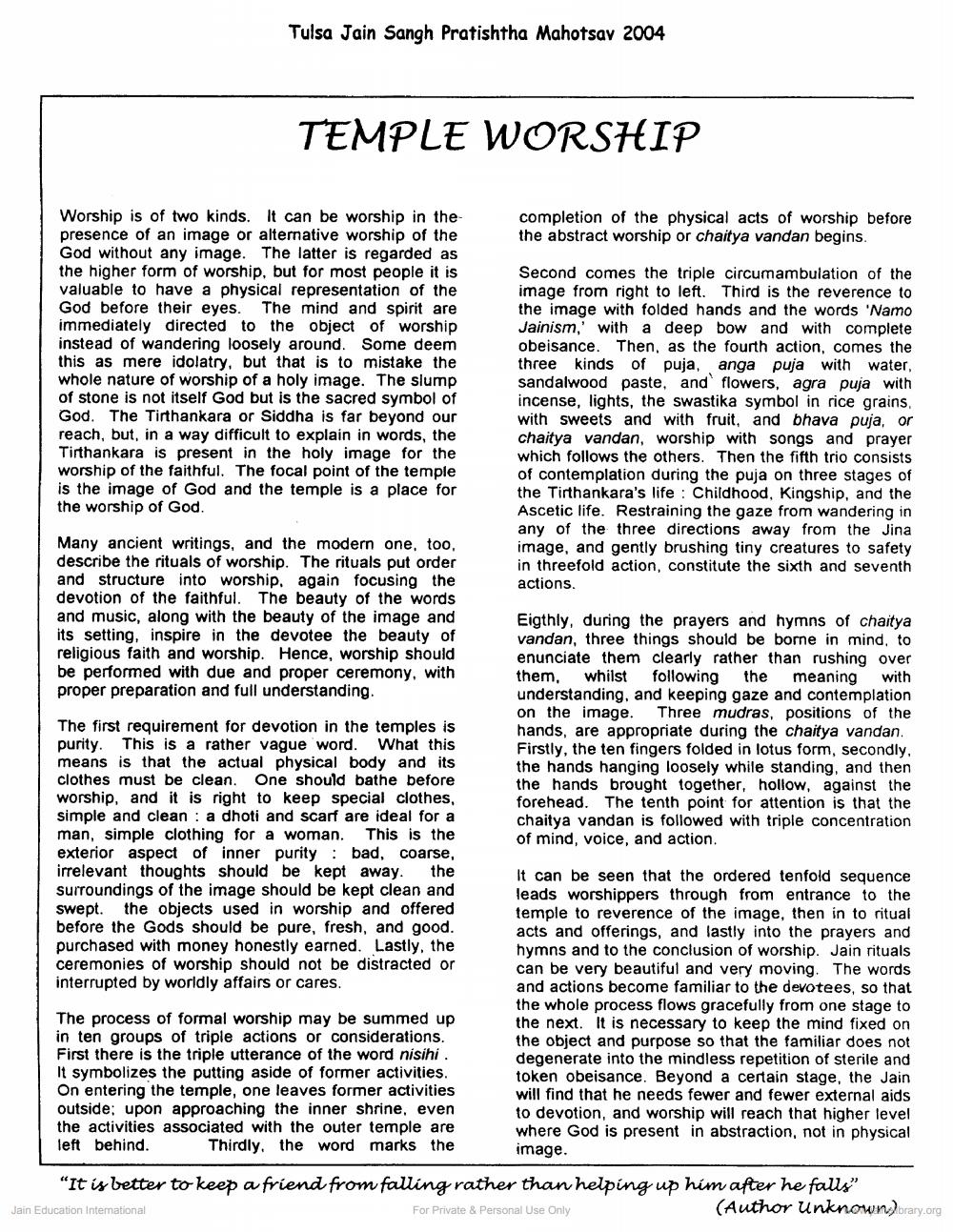________________
Tulsa Jain Sangh Pratishtha Mahotsav 2004
TEMPLE WORSHIP
Worship is of two kinds. It can be worship in thepresence of an image or alternative worship of the God without any image. The latter is regarded as the higher form of worship, but for most people it is valuable to have a physical representation of the God before their eyes. The mind and spirit are immediately directed to the object of worship instead of wandering loosely around. Some deem this as mere idolatry, but that is to mistake the whole nature of worship of a holy image. The slump of stone is not itself God but is the sacred symbol of God. The Tirthankara or Siddha is far beyond our reach, but, in a way difficult to explain in words, the Tirthankara is present in the holy image for the worship of the faithful. The focal point of the temple is the image of God and the temple is a place for the worship of God.
Many ancient writings, and the modern one, too, describe the rituals of worship. The rituals put order and structure into worship, again focusing the devotion of the faithful. The beauty of the words and music, along with the beauty of the image and its setting, inspire in the devotee the beauty of religious faith and worship. Hence, worship should be performed with due and proper ceremony, with proper preparation and full understanding.
The first requirement for devotion in the temples is purity. This is a rather vague word. What this means is that the actual physical body and its clothes must be clean. One should bathe before worship, and it is right to keep special clothes, simple and clean a dhoti and scarf are ideal for a man, simple clothing for a woman. This is the exterior aspect of inner purity bad, coarse, irrelevant thoughts should be kept away. the surroundings of the image should be kept clean and swept. the objects used in worship and offered before the Gods should be pure, fresh, and good. purchased with money honestly earned. Lastly, the ceremonies of worship should not be distracted or interrupted by worldly affairs or cares.
The process of formal worship may be summed up in ten groups of triple actions or considerations. First there is the triple utterance of the word nisihi. It symbolizes the putting aside of former activities. On entering the temple, one leaves former activities outside; upon approaching the inner shrine, even the activities associated with the outer temple are left behind. Thirdly, the word marks the
completion of the physical acts of worship before the abstract worship or chaitya vandan begins.
Second comes the triple circumambulation of the image from right to left. Third is the reverence to the image with folded hands and the words 'Namo Jainism,' with a deep bow and with complete obeisance. Then, as the fourth action, comes the three kinds of puja, anga puja with water, sandalwood paste, and flowers, agra puja with incense, lights, the swastika symbol in rice grains. with sweets and with fruit, and bhava puja, or chaitya vandan, worship with songs and prayer which follows the others. Then the fifth trio consists of contemplation during the puja on three stages of the Tirthankara's life: Childhood, Kingship, and the Ascetic life. Restraining the gaze from wandering in any of the three directions away from the Jina image, and gently brushing tiny creatures to safety in threefold action, constitute the sixth and seventh actions.
Eigthly, during the prayers and hymns of chaitya vandan, three things should be borne in mind, to enunciate them clearly rather than rushing over them, whilst following the meaning with understanding, and keeping gaze and contemplation on the image. Three mudras, positions of the hands, are appropriate during the chaitya vandan. Firstly, the ten fingers folded in lotus form, secondly, the hands hanging loosely while standing, and then the hands brought together, hollow, against the forehead. The tenth point for attention is that the chaitya vandan is followed with triple concentration of mind, voice, and action.
It can be seen that the ordered tenfold sequence leads worshippers through from entrance to the temple to reverence of the image, then in to ritual acts and offerings, and lastly into the prayers and hymns and to the conclusion of worship. Jain rituals can be very beautiful and very moving. The words and actions become familiar to the devotees, so that the whole process flows gracefully from one stage to the next. It is necessary to keep the mind fixed on the object and purpose so that the familiar does not degenerate into the mindless repetition of sterile and token obeisance. Beyond a certain stage, the Jain will find that he needs fewer and fewer external aids to devotion, and worship will reach that higher level where God is present in abstraction, not in physical image.
"It is better to keep a friend from falling rather than helping up him after he falls" (Author Unknown).
Jain Education International
For Private & Personal Use Only




